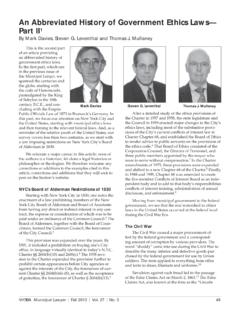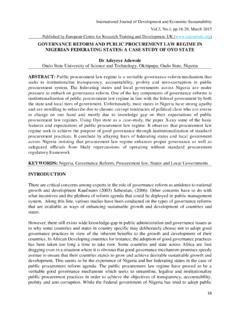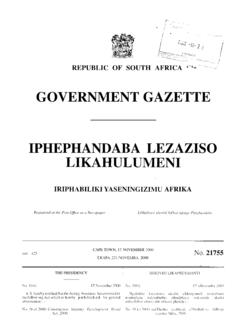Transcription of POLICY STRATEGY TO GUIDE UNIFORMITY IN …
1 1 POLICY STRATEGY TO GUIDE UNIFORMITY IN procurement REFORM PROCESSES IN GOVERNMENT (07-04/2003) 2 EXECUTIVE SUMMARY 1. OBJECTIVES This POLICY STRATEGY intends to achieve the following high level objectives: Promoting UNIFORMITY in the processes relevant to the repealing of tender board legislation in the various spheres of government and devolving the responsibility and accountability for procurement -related functions to acco unting o f f icers/autho rities. Promoting UNIFORMITY in the various spheres of government in the interpretation of government s preferential procurement legislation and policies, also in the context of other broad-based but related legislative and POLICY requirements of government.
2 Replacing the outdated procurement and provisioning practices in government with a supply chain management function and a systematic competitive procedure for the appointment of consultants as an integral part of financial management in government that conforms to internationally accepted best practice principles. Introducing parameters for the promulgation of a regulatory framework in terms of the PFMA and MFMA to ensure compliance to minimum norms and standards; but in such a manner that the principles of co-operative governance are observed. 2. BACKGROUND procurement reforms in government started in 1995 and were directed at two broad focus areas, namely the promotion of principles of good governance and the introduction of a preference system to address certain socio-economic objectives.
3 The procurement reform processes were supported by the introduction of a number of legislative measures, including the adoption of the PFMA and the PPPFA. The procurement reform initiatives were given further impetus when in November 2000, the Report on Opportunities for reform of Government procurement in South Africa served before Cabinet. Cabinet endorsed the 3thrust of the report and directed that the Minister of Finance, in consultation with other relevant Ministers, address the details where necessary. As the procurement reform measures in the national sphere of government were replicated by the other organs of state, very divergent interpretations of government s procurement objectives and strategies became prevalent.
4 To assist the National Treasury in guiding a more uniform implementation approach, a Joint Country procurement Assessment Review (CPAR) was conducted during 2001/02 with the World Bank. The CPAR revealed a number of deficiencies that needed to be addressed. These deficiencies are summarized below under issues that relate to governance aspects and aspects that relate to the interpretation and implementation of the PPPFA and its associated regulations. Governance issues The need to issue a single national legislative framework in terms of section 76(4)(c) of the PFMA and 106(1)(d) of the MFMA to GUIDE UNIFORMITY in procurement reform initiatives in the different spheres of government.
5 The need to replace the outdated and inefficient procurement and provisioning practices in government with a supply chain management function and a systematic competitive system for the appointment of consultants that are fully integrated with the financial management processes in government and that conform to internationally accepted best practices. The need to prescribe minimum norms and standards to promote UNIFORMITY in bid documentation, advertising, receipt and adjudication procedures. The need to monitor value for money performance. Issues relevant to the implementation of the PPPFA and its associated regulations The PPPFA and its supporting regulations are complex and therefore difficult to implement correctly.
6 4 Preferential procurement policies are not clearly formulated and targets are not set for the introduction of sunset and graduation provisions once targets had been achieved. procurement practitioners are not adequately trained in the application of the PPPFA and its associated regulations. The costs and outcomes of the PPPFA are not assessed adequately to evaluate the merits of the system. There is inadequate provision for capacity building for disadvantaged enterprises to successfully compete for government contracts. Certain organs of state apply set-aside practices, instead of the prescribed preference points system.
7 Certain departmental POLICY directives are in conflict with the provisions of the PPPFA. This POLICY STRATEGY intends to address the above aspects by means of appropriate interventions by the responsible authorities in the various spheres of government. In addressing these matters, UNIFORMITY in supply chain management practices and procedures will be promoted in a spirit of co-operative governance. 3. POLICY Interv entions The following POLICY interventions are necessary: Introducing an integrated supply chain management function: The introduction of an integrated supply chain management function intends to address the division between the current outdated procurement and provisioning processes in government that cause the present system to be inefficient in its method of procurement , contract management, inventory/asset control and obsolescence planning.
8 Supply chain management is an integral part of financial management that seeks to introduce internationally accepted best practice principles, whilst at the same time addressing government s preferential procurement POLICY objectives. 5 The integrated supply chain management process, where value is added at every stage of the process, is depicted in the diagram on page 20 of this POLICY STRATEGY document. The process will link to government s budgetary planning processes, but will also strongly focus on the outcomes of actual expenditure in respect of the sourcing of goods and services.
9 Introducing a systematic competitive procedure for the appointment of consultants It is necessary that certain minimum requirements of quality and efficiency be achieved when appointing consultants. It is also necessary to ensure that advice that is being solicited is unbiased, that is, being delivered by a consultant/s acting independently from any affiliation, economic or otherwise, which may cause conflicts between the consultant s interests and those of government. It is also necessary to impose measures to ensure that assignments to consultants are executed in such a way that the ethical principles of the relevant consultancy profession are met at all times.
10 Introducing a national legislative framew ork to enforce minimum norms and standards and UNIFORMITY in respect of supply chain management practices and the interpretation of POLICY objectives: The promulgation of a regulatory framework in terms of section 76(4)(c) of the PFMA and section 106(1)(d) of the MFMA when the latter Act is finally promulgated will establish the POLICY parameters for the repealing of the existing tender board legislation and will prescribe minimum norms and standards for supply chain management practices in government. The regulatory framework will further empower the National Treasury to facilitate the arranging of certain transversally used term contracts in instances where it might be more beneficial from a value for money perspective and/or in achieving government s preferential procurement POLICY objectives.

















